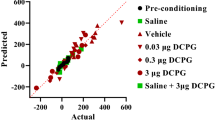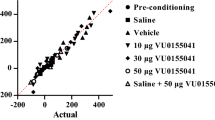Abstract
Objective: To study the effect of glycine site/NMDA (N-methyl-D-aspartate) receptor antagonist MRZ2/576 on the conditioned place preference (CPP) and locomotor activity induced by morphine in mice. Methods: Different doses (1.25, 2.5 and 5 mg/kg, i.p.) of MRZ2/576 were used to evaluate the effect of MRZ2/576 on the acquisition and expression of CPP induced by morphine (5 mg/kg) in mice. In addition, we examined the locomotor activity of mice in conditioning and testing phase of CPP paradigm. Results: MRZ2/576 alone could not establish place preference, but a 5 mg/kg dose of MRZ2/576 could block both acquisition and expression of morphine-induced CPP. In testing phase of CPP, there was no statistical difference for locomotor activity between the groups; injection of MRZ2/576 showed a dose-dependent decrease of locomotor activity on both control and morphine-treated mice, especially 5 mg/kg of MRZ2/576 significantly suppressed the locomotor activity of mice. Conclusion: Based on the present results, we assume that MRZ2/576 can antagonize the rewarding effect of morphine, suggesting that this glycine site/NMDA receptor antagonist could be used to treat addictions due to its light side effect profile.
Similar content being viewed by others
References
Bäckström, P., Hyytia, P., 2006. Ionotropic and metabotropic glutamate receptor antagonism attenuates cue-induced cocaine seeking. Neuropsychopharmacology, 31(4): 778–786. [doi:10.1038/sj.npp.1300845]
Bajo, M., Crawford, E.F., Roberto, M., Madamba, S.G., Siggins, G.R., 2006. Chronic morphine treatment alters expression of N-methyl-D-aspartate receptor subunits in the extended amygdala. J. Neurosci. Res., 83(4):532–537. [doi:10.1002/jnr.20756]
Belozertseva, I.V., Danysz, W., Bespalov, A.Y., 2000a. Short-acting NMDA receptor antagonist MRZ2/576 produces prolonged suppression of morphine withdrawal in mice. Naunyn-Schmiedeberg’s Arch. Pharmacol., 361(3):279–282. [doi:10.1007/s002109900179]
Belozertseva, I.V., Danysz, W., Bespalov, A.Y., 2000b. Effects of short-acting NMDA receptor antagonist MRZ2/576 on morphine tolerance development in mice. Naunyn-Schmiedeberg’s Arch. Pharmacol., 361(6):573–577. [doi:10.1007/s002109900207]
Bienkowski, P., Korso, E., Kostowski, W., Danysz, W., 1999. Effects of N-methyl-D-aspartate receptor antagonists on reinforced and nonreinforced responding for ethanol in rats. Alcohol, 18(2–3):131–137. [doi:10.1016/S0741-8329(98)00075-5]
Carlezon, W.A.Jr, Kosten, T.A., Nestler, E.J., 2000. Behavioral interactions caused by combined administration of morphine and MK-801 in rats. Psychopharmacology, 151(2–3):261–272. [doi:10.1007/s002130000462]
Danysz, W., Parsons, C.G., Karcz-Kubicha, M., Schwaier, A., Popik, P., Wedzony, K., Lazarewiez, J., Quack, G., 1998. GlycineB antagonist as potential therapeutic agents. Previous hopes and present reality. Amino Acids, 14(1–3):235–239. [doi:10.1007/BF01345268]
Danysz, W., Kozelab, E., Parsons, C.G., Sladek, M., Bauer, T., Popik, P., 2005. Peripherally acting NMDA receptor/glycineB site receptor antagonists inhibit morphine tolerance. Neuropharmacology, 48(3):360–371. [doi:10.1016/j.neuropharm.2004.11.005]
del Rosario, C.N., Pacchioni, A.M., Cancela, L.M., 2002. Influence of acute or repeated restraint stress on morphine-induced locomotion: involvement of dopamine, opioid and glutamate receptors. Behav. Brain Res., 134(1–2):229–238. [doi:10.1016/S0166-4328(02)00038-4]
Franken, I.H., Booij, J., van den Brink, W., 2005. The role of dopamine in human addiction: from reward to motivated attention. Eur. J. Pharmacol., 526(1–3):199–206. [doi:10.1016/j.ejphar.2005.09.025]
Harris, G.C., Wimmer, M., Byrne, R., Aston-Jones, G., 2004. Glutamate-associated plasticity in the ventral tegmental area is necessary for conditioning environmental stimuli with morphine. Neuroscience, 129(3):841–847. [doi:10.1016/j.neuroscience.2004.09.018]
Kiefer, F., Jahn, H., Koester, A., Montkowski, A., Reinscheid, R.K., Wiedemann, K., 2003. Involvement of NMDA receptors in alcohol-mediated behavior: mice with reduced affinity of the NMDA R1 glycine binding site display an attenuated sensitivity to ethanol. Biol. Psychiatry, 53(4):345–351. [doi:10.1016/S0006-3223(02)01486-5]
Kretschmer, B.D., 1998. Ligand of the NMDA receptor-associated glycine recognition site and motor behavior. Amino Acids, 14(1–3):227–234. [doi:10.1007/BF01345267]
Liu, Y., Hill, R.H., Arhem, P., von Euler, G., 2001. NMDA and glycine regulate the affinity of the Mg2+-block site in NR1-1a/NR2A NMDA receptor channels expressed in Xenopus oocytes. Life Sci., 68(16):1817–1826. [doi:10.1016/S0024-3205(01)00975-4]
Makarska-Bialek, K., Kaminski, R.M., Czuczwar, S.J., 2005. Influence of the antagonist of the glycine site of NMDA receptors, MRZ2/576, on the anticonvulsant activity of conventional antiepileptic drugs in mice. Pharmacol. Rep., 57(4):458–466.
Narita, M., Aoki, T., Suzuki, T., 2000. Molecular evidence for the involvement of NR2B subunit containing N-methyl-D-aspartate receptors in the development of morphine-induced place preference. Neuroscience, 101(3):601–606. [doi:10.1016/S0306-4522(00)00405-X]
Narita, M., Aoki, T., Ozaki, S., Yajima, Y., Suzuki, T., 2001. Involvement of protein kinase Cγ isoform in morphine induced reinforcing effects. Neuroscience, 103(2):309–314. [doi:10.1016/S0306-4522(00)00572-8]
Narita, M., Kato, H., Miyoshi, K., Aoki, T., Yajima, Y., Suzuki, T., 2005. Treatment for psychological dependence on morphine: usefulness of inhibiting NMDA receptor and its associated protein kinase in the nucleus accumbens. Life Sci., 77(18):2207–2220. [doi:10.1016/j.lfs.2005.04.015]
Nestler, E.J., 2005. Is there a common molecular pathway for addiction? Nat. Neurosci., 8(11):1445–1449. [doi:10.1038/nn1578]
Panos, J.J., Rademacher, D.J., Renner, S.L., Steinpreis, R.E., 1999. The rewarding properties of NMDA and MK-801 (Dizocilpine) as indexed by the conditioned place preference paradigm. Pharmacol. Biochem. Behav., 64(3):591–595. [doi:10.1016/S0091-3057(99)00155-0]
Papp, M., Gruca, P., Willner, P., 2002. Selective blockade of drug-induced place preference conditioning by ACPC, a functional NDMA-receptor antagonist. Neuropsychopharmacology, 27(5):727–744. [doi:10.1016/S0893-133X(02)00349-4]
Parsons, C.G., Danysz, W., Bartmann, A., Spielmanns, P., Frankiewicz, T., Hesselink, M., Eilbacher, B., Quack, G., 1999. Amino-alkyl-cyclohexanes are novel uncompetitive NMDA receptor antagonists with strong voltage-dependency and fast blocking kinetics: in vitro and in vivo characterization. Neuropharmacology, 38(1):85–108. [doi:10.1016/S0028-3908(98)00161-0]
Pláteník, J., Kuramoto, N., Yoneda, Y., 2000. Molecular mechanisms associated with long-term consolidation of the NMDA signal. Life Sci., 67(4):335–364. [doi:10.1016/S0024-3205(00)00632-9]
Quartaroli, M., Fasdelli, N., Bettelini, L., Maraia, G., Corsi, M., 2001. GV196771A, an NMDA receptor/glycine site antagonist, attenuates mechanical allodynia in neuropathic rats and reduces tolerance induced by morphine in mice. Eur. J. Pharmacol., 430(2–3):219–227. [doi:10.1016/S0014-2999(01)01278-X]
Rezayof, A., Zarrindast, M.R., Sahraei, H., Haeri-Rohani, A., 2003. Involvement of dopamine receptors of the dorsal hippocampus on the acquisition and expression of morphine-induced place preference in rats. J. Psychopharmacol., 17(4):415–423. [doi:10.1177/0269881103174005]
Schildein, S., Agmo, A., Huston, J.P., Schwarting, R.K., 1998. Intraacumbens injections of substance p, morphine, and amphetamine: effect on conditioned place preference and behavioral activity. Brain Res., 790(1–2):185–194. [doi:10.1016/S0006-8993(98)00062-6]
Tzschentke, T.M., 1998. Measuring reward with the conditioned place preference paradigm: a comprehensive review of drug effects, recent progress and new issue. Prog. Neurobiol., 56(6):613–672. [doi:10.1016/S0301-0082(98)00060-4]
Tzschentke, T.M., 2001. Pharmacology and behavioral pharmacology of the mesocortical dopamine system. Prog. Neurobiol., 63(3):241–320. [doi:10.1016/S0301-0082(00)00033-2]
Tzschentke, T.M., 2002. Glutamatergic mechanisms in different disease state: overview and therpeutical implication—an introduction. Amino Acids, 23(1–3):147–152. [doi:10.1007/s00726-001-0120-8]
Xi, Z.X., Stein, E.A., 2002. Blockade of ionotropic glutamatergic transmission in the ventral tegmental area reduces heroin reinforcement in rat. Psychopharmacology, 164(2):144–150. [doi:10.1007/s00213-002-1190-3]
Zarrindast, M.R., Azami, B.N., Rostami, P., Rezayof, A., 2006. Repeated administration of dopaminergic agents in the nucleus accumbens and morphine-induced place preference. Behav. Brain Res., 169(2):248–255. [doi:10.1016/j.bbr.2006.01.011]
Zhu, H., Ho, I.K., 1998. NMDA-R1 antisense oligonucleotide attenuate withdrawal signs from morphine. Eur. J. Pharmacol., 352(2–3):151–156. [doi:10.1016/S0014-2999(98)00367-7]
Author information
Authors and Affiliations
Additional information
Project supported by the National Basic Research Program (973) of China (No. 2003CB515402), and the Science and Technology Council of Zhejiang Province (No. 2005C23G2010166), China
Rights and permissions
About this article
Cite this article
Zhu, Yp., Long, Zh., Zheng, Ml. et al. Effect of glycine site/NMDA receptor antagonist MRZ2/576 on the conditioned place preference and locomotor activity induced by morphine in mice. J. Zhejiang Univ. - Sci. B 7, 998–1005 (2006). https://doi.org/10.1631/jzus.2006.B0998
Received:
Accepted:
Issue Date:
DOI: https://doi.org/10.1631/jzus.2006.B0998




